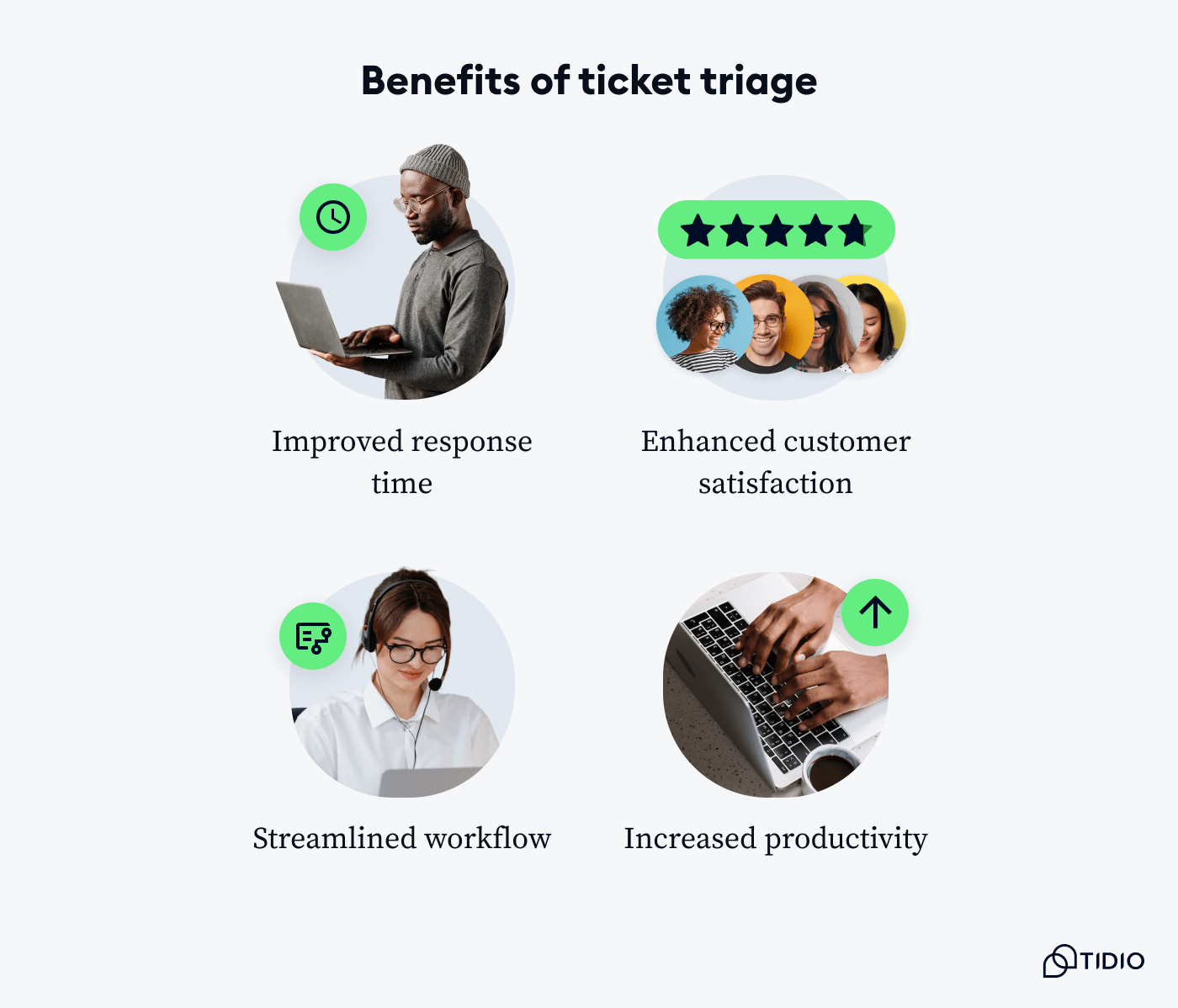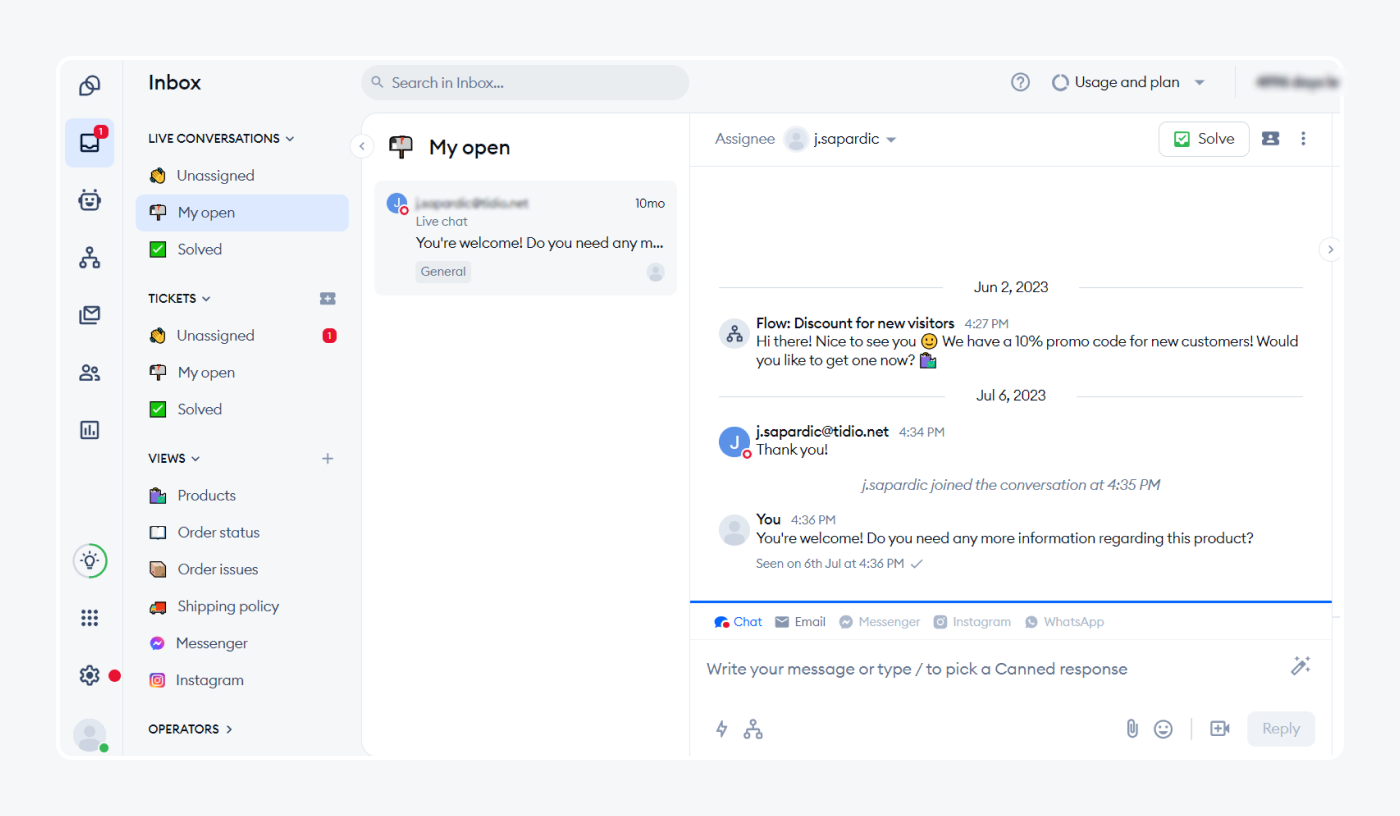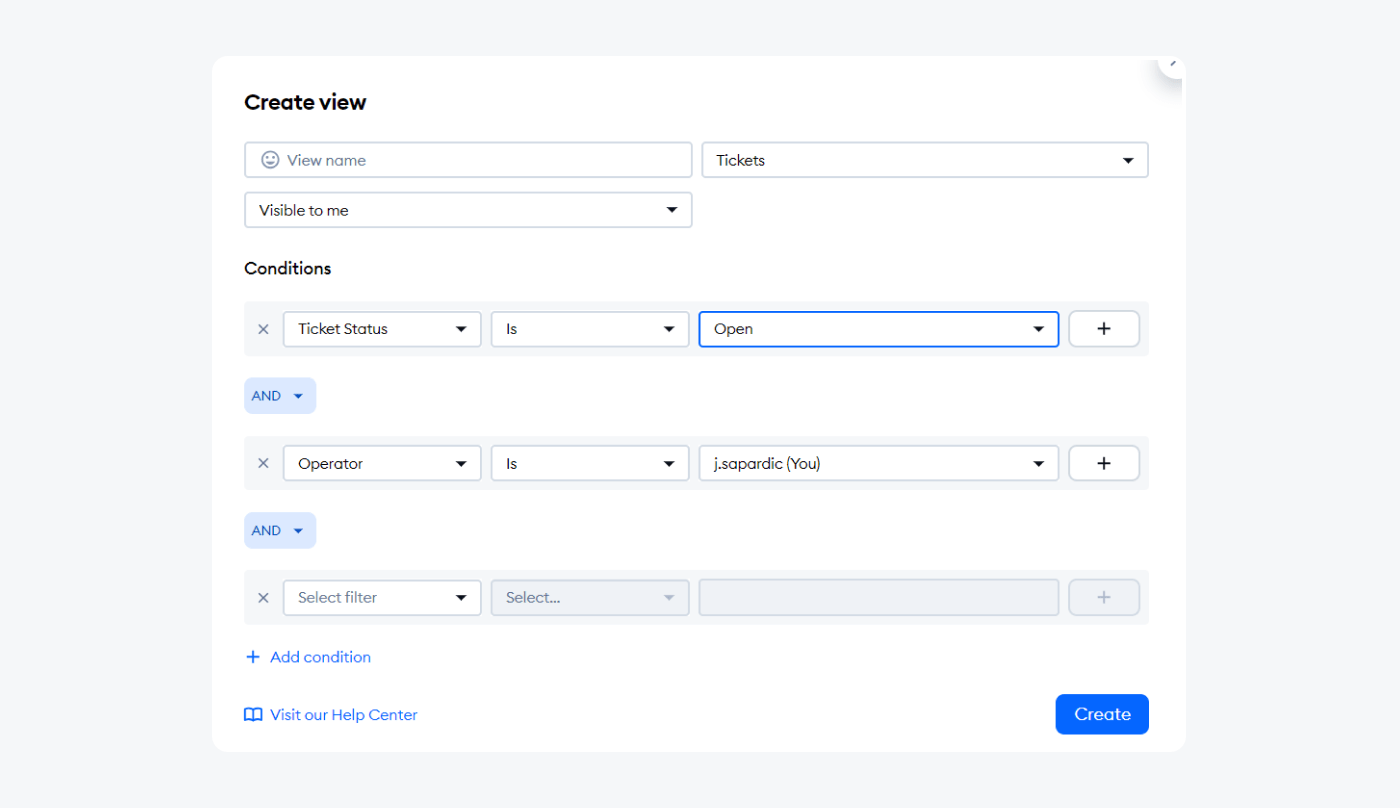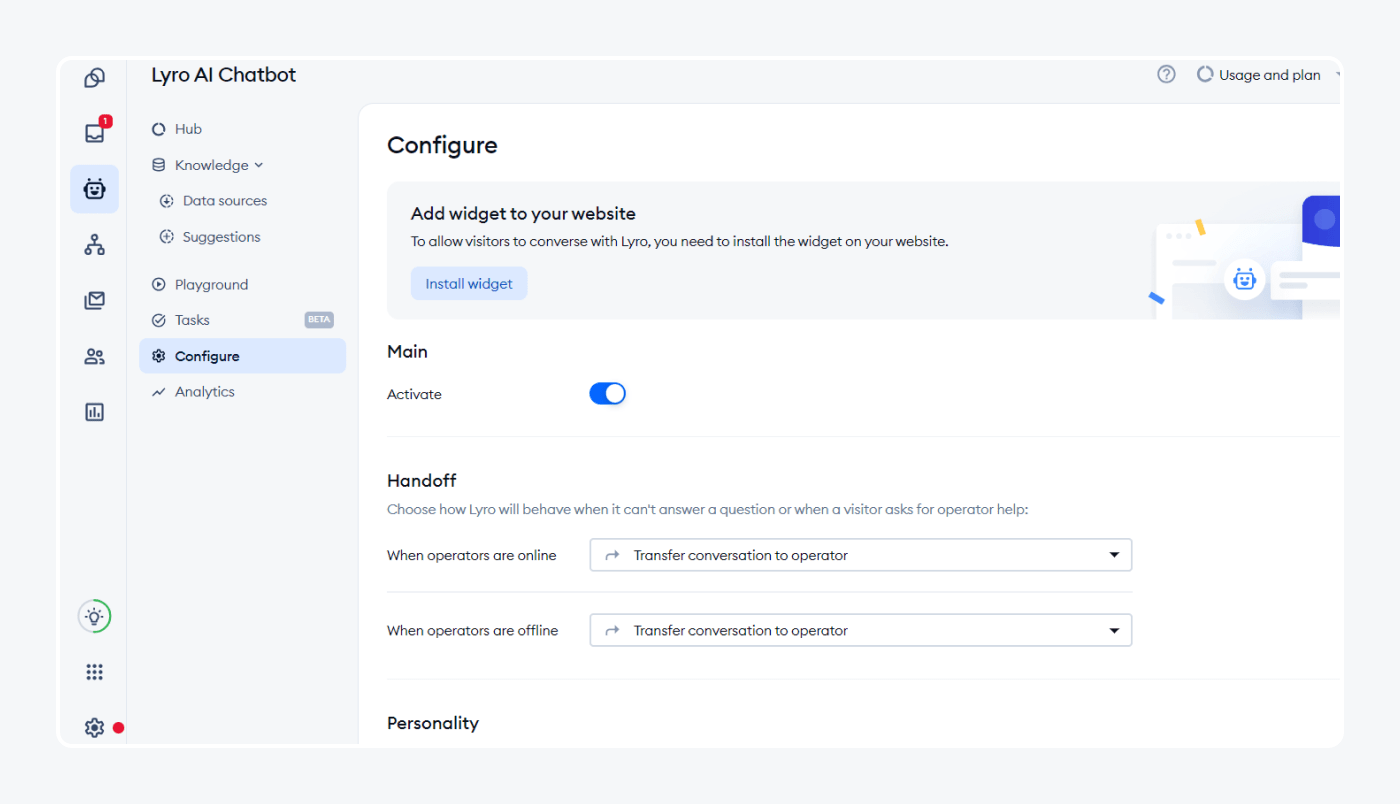Ticket triage is a crucial process in efficiently managing customer support tickets. By prioritizing and categorizing incoming requests, support teams can ensure that urgent issues are addressed promptly.
But how do you make the most out of it?
Don’t worry—we’ve got your back.
We collected seven practical tips to help you successfully triage support tickets. From setting clear priorities to establishing effective communication, these best practices will empower your team to provide timely and efficient support to your customers.
Sounds good?
Let’s dive right in!
Successfully triage tickets using Tidio help desk
First things first—
What is ticket triage?
Ticket triage is the process of categorizing and prioritizing incoming support tickets based on their urgency and impact. When a customer submits a ticket, the agent first evaluates it to determine the request’s severity and whether it requires immediate attention or can be addressed later.

For example, a customer reporting a critical system outage would be classified as high priority and require immediate assistance. On the other hand, a minor inquiry about a product feature would be classified as low priority.
Here’s what the process of triaging tickets can look like:
- When a support ticket is submitted, it’s reviewed to determine the nature of the issue
- The ticket is categorized based on its severity, such as high, medium, or low priority
- High-priority tickets, like critical system outages, are flagged for immediate attention
- Medium-priority tickets, like customer complaints or technical issues, are scheduled for addressing based on availability
- Low-priority tickets, like general inquiries or feature requests, are queued for resolution after higher-priority issues are handled
- Throughout the customer support triage process, clear communication channels are maintained to keep users informed of progress and resolution timelines
Read more: Check out the essential ticketing system features.
With that out of the way, let’s take a look at the importance of ticket triage in your processes.
Why is ticket triage important?
Ticketing triage plays a vital role in the efficient help desk service management of support tickets, ensuring that urgent issues are addressed promptly. By prioritizing and categorizing incoming tickets, support teams can streamline their workflow and provide timely assistance to their customers.
Here are the key benefits of ticketing support triage:

- Improved response times
Customer request triage enables support teams to tackle high-priority issues, leading to faster response times. This is vital as 83% of users want to get assistance right after establishing contact.
- Enhanced customer satisfaction
Efficient customer service triage leads to better prioritization of ticket escalations which results in higher levels of client satisfaction and loyalty in the long run. Shoppers appreciate timely responses and solutions to their concerns. In fact, 50% of consumers consider efficient customer service key in retaining brand loyalty.
- Streamlined workflow
Ticket triage helps streamline the support process by organizing incoming tickets based on priority levels. This allows support teams to work more efficiently, reduce ticket backlogs, and ensure that all issues are addressed in a timely manner.
- Increased productivity
With ticket triage, customer support agents can focus on resolving high-impact issues first, leading to greater productivity and a more streamlined workload. In fact, a whopping 91% of agents think having an effective help desk system leads to increased productivity!
Read more: Check out some useful help desk tips and best practices for efficient ticketing management.
Now that we’ve explored the importance of ticket triage, let’s delve into some key tips for doing the most out of this process.
7 Tips for an efficient ticketing triage process
Successful ticket triage involves prioritizing and categorizing tickets to ensure that urgent issues are addressed promptly. By implementing the following tips, your service teams can streamline their workflow, improve response times, and deliver exceptional customer support.

1. Define clear priority levels
Establishing clear priority levels for incoming tickets is essential for efficient ticket triage. Create a structured system that categorizes tickets into high, medium, and low priority based on the urgency and impact of the issue.
For example, a critical system outage would be classified as high priority, while a feature request might be considered low priority. By defining these levels, your IT support and other teams can quickly identify and address urgent issues, ensuring that critical matters are not overlooked in a sea of inquiries.
Read more: Explore the best open-source help desk systems on the market.
2. Utilize a ticketing system
Implementing a dedicated ticketing system can streamline the ticket triage process by centralizing all customer inquiries in one place. A robust platform in this category allows support teams to track, prioritize, and assign tickets efficiently, ensuring that no inquiry gets overlooked.

You should choose a ticketing system with features such as automated ticket routing, customizable ticket tags, and reporting capabilities to enhance visibility and control over the triage process. By doing so, support teams can improve collaboration and provide a seamless customer support experience.
Improve customer service with a practical ticket triage system
3. Assign clear roles and responsibilities
Establish clear roles and responsibilities for team members involved in the ticket triage process to ensure accountability and efficiency. Assign the right agents to handle different ticket categories or priority levels based on their expertise and availability.
Also, you should set guidelines for ticket assignment, escalation protocols, and communication channels to streamline the flow of inquiries and avoid bottlenecks. By doing this, support teams can maintain clarity and coordination in managing support tickets. Naturally, this leads to faster resolution times and improved customer satisfaction.
4. Utilize automation tools
Take advantage of automation software to streamline the ticket triage process and improve efficiency. Automation can categorize inquiries, assign them to the appropriate team members, and escalate urgent issues on autopilot.
For instance, setting up automated triggers to flag tickets with specific keywords or phrases can accelerate the triaging process. By leveraging automation tools, such as AI help desk support teams can reduce manual effort, enhance productivity, and ensure that requests are handled quickly and accurately.
Read more: Find out all you need to know about ticketing system automation.
5. Implement SLAs (Service Level Agreements)
Implementing Service Level Agreements (SLAs) can help guide the ticket triage process and set clear expectations for response times and resolution targets. Define SLAs for different priority levels to ensure that high-priority tickets are addressed within a shorter timeframe than lower-priority ones.
For example, you may set an SLA for responding to critical issues within one hour and resolving them within four hours. On the other hand, lower-priority requests may have longer response and resolution targets. By incorporating SLAs into the ticket triage process and adhering to these agreed-upon timelines, support teams can maintain consistency. This further enables you to meet customer expectations and demonstrate a commitment to delivering timely and effective support.
6. Maintain collaboration among team members
Always encourage open communication and collaboration among support team members to enhance the ticket triage process. You can do this by establishing regular team meetings or utilizing collaborative shared inbox tools and other systems to discuss incoming tickets and address challenges collectively.
By adopting this culture of collaboration, your support agents can leverage the diverse expertise of team members to resolve complex issues and deliver superior customer support.
7. Continuously review and refine the triage process
You should regularly examine and optimize the ticket triage process to adapt to changing customer needs and optimize efficiency. Collect feedback from team members and analyze key help desk metrics such as response times and ticket resolution rates to identify areas for improvement.

On top of that, you should make regular adjustments to the triage process, such as updating priority levels or refining automation rules, based on insights gained from ongoing evaluations. Through continuous review and refinement, your support team can fine-tune their ticket triage process in a way that helps them deliver seamless support.
Now you are aware of the essential tips for optimal ticketing triage. So, it’s time to show you how to take care of the triage process using Tidio’s intuitive help desk software.
How to triage support tickets using Tidio
Tidio’s help desk tool offers a convenient way to solve any customer queries in a diligent manner. You can do this by easily turning time-consuming conversations into tickets, assigning the priority of each ticket, automating the process as much as possible, and more.
We’ll show you how to effectively triage tickets in Tidio.
If you want to follow this tutorial along, sign up for a free account. Let’s check how to optimize your customer support workflow to the fullest.
1. Turn conversations into tickets
Tidio’s help desk system allows you to easily turn every conversation into ticket. All you have to do is to hit the Create a ticket button within the conversation window.

Once you do this, a new window will appear, allowing you to fill in the necessary data. This includes the ticket subject, the assignee, and the email contents that will get sent to the customer upon ticket creation.
2. Manage ticket priority
The next step to take for a successful triage is to determine and set the priority of your ticket. You can easily do this within the ticket creation window. The options available include Low, Normal, and Urgent priority.

3. Leverage automated ticket routing options
You can significantly speed up your response time by automatically routing tickets to the right department.
To do this, you need to access Helpdesk in Tidio’s Settings panel. Then, select the department from the drop-down menu next to the specific mailbox.

4. Use advanced ticket filtering
You can also manage specific customer requests by using custom filtering options. To do this in Tidio, go to Inbox >> Views and click on Create view.
From here on, you’ll be able to create a view name, choose who it’ll be visible to and add custom conditions by hitting on +Add condition button.

Here you have plenty of options at your disposal to truly streamline your triaging. For example, if the email subject in a ticket contains certain phrasing, you can select the right team member who will handle this ticket. If the ticket status is open, pending, or solved, you can further select the operator that will handle the tickets with said statuses. And the list of options and conditions continues.
Just make sure to select the Create button once you’re done.
Read more: Check out our knowledge base and learn more about how to create custom ticket views in Tidio.
5. Use internal notes to streamline workflow and team collaboration
Another great way to further triage requests and encourage collaboration in the help desk workflow is to use the internal notes option.
Within every conversation/ticket, you will see the option of adding internal notes at the bottom. You just have to turn on the toggle switch for internal notes and add your message. Then, hit the Add NOTE button.

The note itself won’t be visible to customers—only to other agents.
6. Automate answers to commonly asked questions
Help desk automation plays a crucial role in the ticket triage process. It ensures faster response times, minimizes errors, and improves your team’s overall efficiency and productivity in handling all requests.
You can easily automate answers to the most common queries by using the help of AI chatbots like Tidio’s Lyro. This conversational AI can be programmed to answer commonly asked questions using the Data sources option. Here you can add knowledge to it using manually added question-answer pairs, or allowing Lyro to pull an FAQ from your website’s URL.

After that, you can use the Configure option to optimize Lyro further. Once there, you’ll be able to choose how the AI will behave when operators are online and offline. Also, you can enable or disable the use of emojis, and select all the channels on which Lyro will be visible to users.

Read more: Check out the Lyro case study and find out how Tidio’s support team achieved 58% automation.
Ticket triage: key takeaway
Ticketing and help desk triage plays a crucial role in efficiently managing incoming requests. By accurately categorizing, prioritizing, and assigning tickets, you can streamline support processes, increase customer satisfaction, and improve your team’s productivity.
To summarize, the best strategies for ticketing triage include:
- Defining priority levels
- Utilizing a triage with a ticketing system
- Assigning clear roles and responsibilities
- Utilizing automation tools
- Implementing SLAs (Service Level Agreements)
- Establishing team collaboration
- Continuously reviewing and refining the process
We advise you to apply these tips to ensure faster problem resolution and enhance the overall customer experience.
And if you want to try out one of the best help desk systems offering AI for your support triage, why not give Tidio a try?
Speed up your ticket triaging with Tidio BOFU helpdesk
Frequently Asked Questions
The key factors to consider when prioritizing tickets during triage include the potential impact on the customer, the severity of the problem, the volume and frequency of similar tickets, and available resources for the team to solve issues.
The primary goal of this task is to efficiently manage incoming support tickets by categorizing, prioritizing, and optimizing requests based on their urgency, impact, and other relevant factors. By effectively triaging tickets, support teams can ensure that high-priority issues are addressed promptly, resources are allocated efficiently, and customer inquiries are attended to in a timely manner. Ultimately, the main goal of ticket triaging is to streamline the support workflow and enhance response times to deliver exceptional customer support.
In a customer support ticketing system, a practical example of ticket triage would be when a customer submits a ticket reporting a login issue preventing them from accessing their account. The support team recognizes the severity of the issue and immediately prioritizes it as a high priority due to the urgent impact on the customer’s ability to use the service. The ticket is promptly assigned to a technical specialist who addresses the login issue, ensuring that the customer’s problem is resolved in a timely manner to restore access to their account.
Start by identifying your specific requirements and objectives for ticket triaging, such as the volume of incoming tickets, the complexity of issues, team collaboration needs, and integration capabilities with existing systems. Then, research different ticket triaging tools available in the market and evaluate their features, functionalities, and user reviews. Look for tools that offer automation, customizable workflows, reporting capabilities, and scalability to meet your evolving needs. Finally, determine if the tool can seamlessly integrate with your existing helpdesk or CRM systems, communication channels, and other relevant applications.

